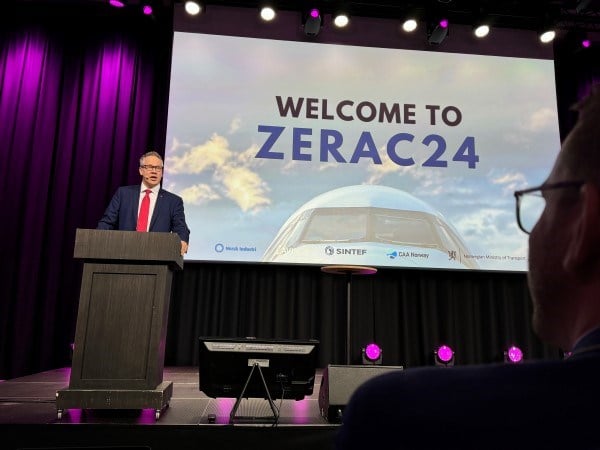Zero Emission Regional Aviation Conference 2024
Tale/innlegg | Dato: 17.10.2024 | Samferdselsdepartementet
Opening speech by the Minister of Transport, Jon-Ivar Nygård, at the Zero Emission Regional Aviation Conference in Oslo 17. October 2024.

Foto: Samferdselsdepartementet
Minister Carlson, Ladies and Gentlemen,
For the third time, I have the distinct honour of opening the Zero Emission Regional Aviation Conference which my Ministry is co-hosting alongside Norway’s state airport operator Avinor, the Norwegian Civil Aviation Authority, the Norwegian research institute SINTEF, and the Federation of Norwegian Industries.
It’s been incredibly exciting to watch this annual conference track the remarkable progress in zero- and low-emission aviation, as we move steadily from the concept phase to testing and eventually to full-scale implementation.
I’m thrilled to see that, just like in previous years, we’ve managed to bring together a diverse array of stakeholders from across the aviation ecosystem, as well as from the investment community.
The important public support schemes for research and green transition The Research Council of Norway, Enova and SIVA are also participating.
Nordic commitment
Furthermore, I want to give a special thank you the Swedish Minister for Infrastructure and Housing, Andreas Carlson, for accepting our invitation to join us today and to deliver an opening address.
Zero- and low-emission aviation has been an important topic on the agenda in the latest meetings among the Nordic Transport ministers.
At our latest meeting in Gothenburg this August, we signed a declaration to further strengthen Nordic cooperation in promoting the development of air routes operated by electric aircraft. This declaration underscores the shared interest and commitment of the Nordic in advancing, facilitating and accelerating the introduction of zero- and low-emission aviation.
Another initiative I want highlight is the establishment of the EU-Norway Green Alliance. The agreement, signed on April 24th last year by our Prime Minister, Jonas Gahr Støre, and the President of the European Commission, Ursula Von der Leyen, identifies Green Aviation as a key area of cooperation.
Our goal is to use this platform to work together with the EU in accelerating the transition we are all seeking.
Sustainable and safe aviation
At last year’s ZERAC, I discussed my government’s white paper “Sustainable and safe aviation”, which provides a comprehensive review of our policies to foster an environmentally sustainable aviation sector.
Our proposed goals and measures have been further detailed in the National Transport Plan submitted to the Parliament in March this year.
In this plan, we prioritized 1 billion Norwegian kroner to over a twelve-year period to accelerate transition to zero-and low-emission aviation. This includes exploring a range of measures covering regulation, ownership, procurement of public service obligation routes, financial support and governance.
Norway as a test arena
Our first major step is establishing Norway as an international arena for testing and demonstration. I am delighted to announce that funds have been allocated for this purpose in our proposed state budget for 2025.
Through this test arena, we are investing time and resources to reduce barriers to testing and demonstration, prepare the ecosystem for new technologies and understand more about the possibilities and challenges connected to it.
The CEO of Avinor, Abraham Foss, and the Director General of the Norwegian Civil Aviation Authority, Lars Kobberstad, will provide more details on this initiative later today.
A country suited for testing
I firmly believe Norway is uniquely suited for testing and demonstration, and eventually commercial use of zero-and low-emission aircraft.
We have:
- an aviation industry committed to reducing emissions,
- a decentralized airport network with airports in all different sizes mainly operated by our state operator Avinor,
- a substantial regional air transport market,
- a proactive Civil Aviation Authority,
- and a diverse supply-side industry - including battery-electric and hydrogen propulsion technologies.
Norway also has extensive experience in transitioning both road transport and parts of the maritime sector to zero-and low emission technologies.
We are now expanding this focus to aviation. For a country on the outskirts of Europe with long distances, challenging topography and climate, where road- and rail transport often are not viable alternatives, air transport is and will continue to be essential for domestic and international connectivity.
We therefore need environmentally sustainable air transport in the future if we want to continue to support economic development and maintain existing settlement patterns.
If we succeed in creating a net-zero aviation sector - as we must - the need for other forms of land demanding transport infrastructure can be reduced. This is an often under-communicated aspect of the aviation industry.
New technologies
New technologies can also create new market opportunities or even entirely new markets. Advanced Air Mobility with new types of aircraft, that often can take off and land vertically, may open air transport to areas underserved or not served at all by air transport today.
My government is now working on a white paper on drones and new air mobility, which will further explore these opportunities. We hope to publish this white paper next spring.
While new energy carriers like battery- electric and hydrogen are the main focus of today’s conference, I want to emphasize that sustainable aviation fuel is, and will continue to be, a crucial part of reducing aviation’s climate footprint.
Other measures, such as more fuel-efficient aircraft, new technology in air traffic management and greener airport operations, will also contribute to reducing emissions.
Finally, I want to express my gratitude for your participation here today. The agenda covers many important topics, and contributions from various stakeholders across the aviation sector and beyond are invaluable. We need to share knowledge and have robust discussions. There is great value in different perspectives.
Thank you.